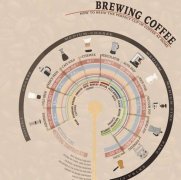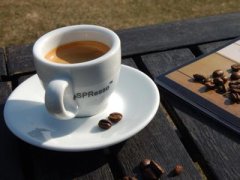The way to make coffee how to get the perfect taste of coffee
To really understand what is good coffee, we must start by understanding the taste of coffee.
The history of measuring coffee taste dates back to the 1850s, when Professor Lockhart, a chemistry professor at the Massachusetts Institute of Technology, conducted a series of surveys on coffee taste preferences, and Professor Lockhart published his findings in the form of coffee production control charts. The picture clearly divides people's judgment on the taste of coffee. This result has not changed much so far.
It is generally believed that the perfect coffee to drink is that the coffee extraction rate (Extraction) is between 18% and 22%, and the coffee brewing concentration (Brew strength) is between 1.15% and 1.35%. The following is Professor Lockhart's diagram of the effect of coffee extraction rate and coffee brewing concentration on coffee taste:

Note:
Extraction rate: refers to the percentage of coffee ingredients extracted from coffee beans. The extraction rate is affected by many factors, such as the soil in which raw beans grow, the technology of baking, etc.
Brewing concentration: refers to the percentage of coffee ingredients in the coffee cup.
So, according to the coffee brewing control table, we want to prepare the coffee with the best taste, which is to control the concentration and extraction rate within the perfect taste area, which seems more difficult to control. The simple way is to use the golden ratio: 1 gram of ground coffee beans mixed with 17.42 grams of water. For most coffees, the brewing concentration of 1.28% and the extraction rate of 20% can be achieved with this ratio. You can use this as a starting point to adjust the amount of coffee or water to achieve what you think is the perfect taste.
An easy mistake is to confuse the extraction rate with the brewing concentration, which refers to the percentage of the coffee ingredient in the coffee cup, and the extraction rate refers to the amount of coffee extracted from the beans. Therefore, espresso has nothing to do with bitterness, caffeine content or roasting, but with the ratio of coffee to water.
(this article is reproduced)
Important Notice :
前街咖啡 FrontStreet Coffee has moved to new addredd:
FrontStreet Coffee Address: 315,Donghua East Road,GuangZhou
Tel:020 38364473
- Prev

Six prerequisites for making perfect Coffee by Coffee making method
We already know the golden ratio of coffee with perfect taste. So, what is the premise of making perfect coffee? 1. Buy high-quality coffee beans-it's best to choose whole beans rather than ground coffee powder;-although high-quality coffee can be preserved for a year after roasting, most coffee beans reach the strongest aroma in a few days after roasting, and then the aroma of coffee slowly fades away, so
- Next

The basic knowledge of fine coffee decaf coffee production process and principles
Decaffeinated coffee is coffee with only trace amounts of caffeine. Coffee contains many ingredients and substances, among which caffeine has a significant impact on the human body. Decaf coffee is the best choice for many coffee drinkers who are not physically fit to consume caffeine. In general, Arabica coffee beans contain
Related
- Beginners will see the "Coffee pull flower" guide!
- What is the difference between ice blog purified milk and ordinary milk coffee?
- Why is the Philippines the largest producer of crops in Liberia?
- For coffee extraction, should the fine powder be retained?
- How does extracted espresso fill pressed powder? How much strength does it take to press the powder?
- How to make jasmine cold extract coffee? Is the jasmine + latte good?
- Will this little toy really make the coffee taste better? How does Lily Drip affect coffee extraction?
- Will the action of slapping the filter cup also affect coffee extraction?
- What's the difference between powder-to-water ratio and powder-to-liquid ratio?
- What is the Ethiopian local species? What does it have to do with Heirloom native species?

